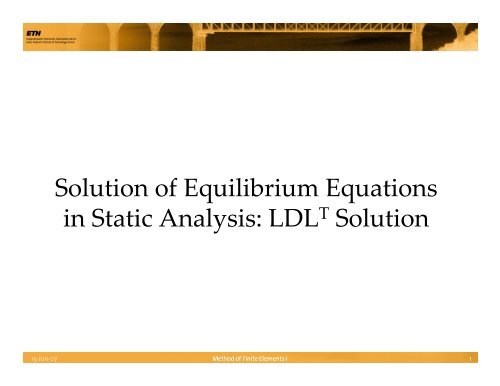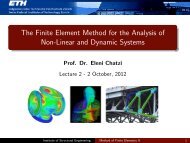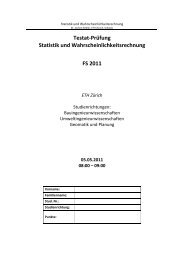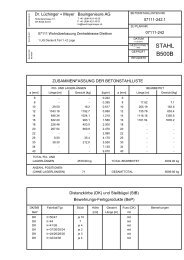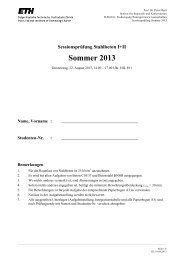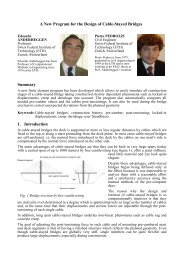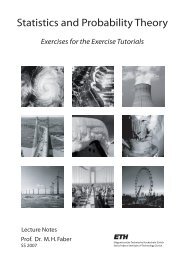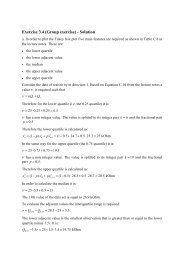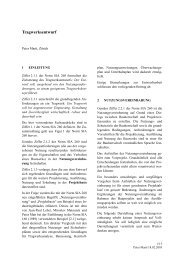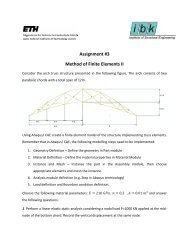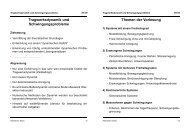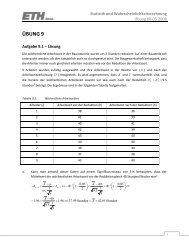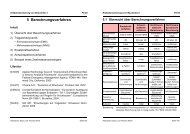Solution of Equilibrium Equations in Static Analysis: LDLT Solution ...
Solution of Equilibrium Equations in Static Analysis: LDLT Solution ...
Solution of Equilibrium Equations in Static Analysis: LDLT Solution ...
You also want an ePaper? Increase the reach of your titles
YUMPU automatically turns print PDFs into web optimized ePapers that Google loves.
<strong>Solution</strong> <strong>of</strong> <strong>Equilibrium</strong> <strong>Equations</strong><br />
<strong>in</strong> <strong>Static</strong> <strong>Analysis</strong>: LDL T <strong>Solution</strong><br />
15-Jun-07<br />
Method <strong>of</strong> F<strong>in</strong>ite Elements I<br />
1
Contents<br />
• Gauss elim<strong>in</strong>ation<br />
i i<br />
• Physical <strong>in</strong>terpretation <strong>of</strong> Gauss elim<strong>in</strong>ation <strong>in</strong> the<br />
context <strong>of</strong> f<strong>in</strong>ite element problems<br />
• The LDL T ‐solution:<br />
• Introduction to the procedure<br />
• Algorithm used <strong>in</strong> computational implementations<br />
• Efficiency<br />
• Error considerations<br />
• Related methods<br />
15-Jun-07<br />
Method <strong>of</strong> F<strong>in</strong>ite Elements I<br />
2
Review ‐ Matrices<br />
• Positive‐def<strong>in</strong>iteness: v T Av > 0 for all vectors v (semi‐<br />
positive def<strong>in</strong>ite: v T Av ≥ 0 )<br />
⎡1<br />
2 0 0 0 0 0<br />
⎢<br />
• Bandwidth <strong>of</strong> a matrix A:<br />
⎢<br />
⎢<br />
3 4 5 0 0 0 0<br />
6 7 8 9 0 0 0<br />
• p ⎥ ⎥⎥⎥⎤<br />
1 + p 2 + 1, where a ij = 0 for j > i + p 2 or i > j + p ⎢<br />
1 0 1 2 3 4 0 0<br />
• Skyl<strong>in</strong>e <strong>of</strong> a matrix A:<br />
• for j, j = 1,...,n: m j = i’ with a ij = 0for i < i’<br />
m T = [1 1 2 3 4 5 6]<br />
• Column heights <strong>of</strong> a matrix: h i = i ‐ m i for i = 1,...,n<br />
h T = [0 1 1 1 1 1 1]<br />
(maximum column height ht = half‐bandwidth m K )<br />
⎢<br />
⎢0<br />
0 5 6 7 8 0<br />
⎢<br />
⎢0<br />
0 0 9 1 2 3<br />
⎢<br />
⎥ ⎥⎥⎥⎥⎥ ⎣0<br />
0 0 0 4 5 6⎦<br />
p 1 =2, p 2 =1<br />
15-Jun-07<br />
Method <strong>of</strong> F<strong>in</strong>ite Elements I<br />
3
Gauss elim<strong>in</strong>ation<br />
Carl F. Gauss, ca. 1850, solution <strong>of</strong> l<strong>in</strong>ear<br />
systems <strong>of</strong> equations<br />
In general:<br />
Solve Ax=b for x<br />
where A is a matrix <strong>of</strong> coefficients,<br />
x is the vector <strong>of</strong> unknowns,<br />
b is the right‐hand side vector<br />
simply supported<br />
beam with 4 transl. d<strong>of</strong>s<br />
R 2<br />
U 1 U 2 U 3 U 4<br />
15-Jun-07<br />
In the context <strong>of</strong> f<strong>in</strong>ite element problems:<br />
Solve KU=R for U<br />
where K is the stiffness matrix,<br />
U is the displacement vector,<br />
R is the load vector K U R<br />
Method <strong>of</strong> F<strong>in</strong>ite Elements I<br />
4
Gauss elim<strong>in</strong>ation<br />
In a Gauss elim<strong>in</strong>ation, we reduce the matrix <strong>of</strong> coefficients to an upper<br />
triangular form, by a successive addition <strong>of</strong> multiples <strong>of</strong> the i th row<br />
(i= 1,…,n –1) to the rema<strong>in</strong><strong>in</strong>g n – irows j (j = i+ 1,…,n).<br />
r2 = r2 + 4/5 r1;<br />
r3 = r3 + (‐1/5) r1;<br />
r4 = r4;<br />
r3 = r3 + 16/14 r2;<br />
r4 = r4 + (‐5/14) r2;<br />
r4 = r4 + 20/15 r3;<br />
15-Jun-07<br />
Method <strong>of</strong> F<strong>in</strong>ite Elements I<br />
5
Gauss elim<strong>in</strong>ation<br />
The result is an upper‐triangular matrix which we can solve for the<br />
unknowns U i <strong>in</strong> the order U n ,UU<br />
n‐1 ,…,UU<br />
1 .<br />
5 -4 1 0<br />
0 14/5 -16/5 1<br />
0 0 15/7 -20/7<br />
0 0 0 5/6<br />
U 1<br />
U 2<br />
U 3<br />
U 4<br />
0<br />
1<br />
8/7<br />
7/6<br />
• After step i (i.e. after the full addition procedure <strong>in</strong>volv<strong>in</strong>g multiples<br />
l<br />
<strong>of</strong> row i), the lower right (n‐i) x (n‐i) submatrix is symmetric →<br />
storage implications<br />
• <strong>Solution</strong> based on non‐vanish<strong>in</strong>g ihi i th diagonal element <strong>of</strong> coefficient<br />
i<br />
matrix <strong>in</strong> step i.<br />
• The operations on the coefficient matrix are <strong>in</strong>dependent <strong>of</strong> the right‐<br />
hand side vector.<br />
• Any desirable order <strong>of</strong> elim<strong>in</strong>ations may be chosen.<br />
15-Jun-07<br />
Method <strong>of</strong> F<strong>in</strong>ite Elements I<br />
6
Physical Interpretation<br />
A physical <strong>in</strong>terpretation <strong>of</strong> the operations performed <strong>in</strong> a Gauss elim<strong>in</strong>ation:<br />
5 -4 1 0<br />
6 -4 1<br />
symmetric<br />
6 -4<br />
U 1<br />
U 2<br />
U 3<br />
U 4<br />
0<br />
0<br />
0<br />
5 0<br />
First equation: 5 U 1 –4 U 2 + U 3 = 0 ⇔ U 1 = 4/5 U 2 –1/5 U 3<br />
Elim<strong>in</strong>ation i <strong>of</strong> U 1 from equations 2, 3 and 4 yields ild the lower right 3 x 3 submatrix<br />
which we get after the first step <strong>of</strong> the Gauss elim<strong>in</strong>ation <strong>of</strong> the orig<strong>in</strong>al matrix:<br />
14/5 -16/5 1<br />
-16/5 29/5 -4<br />
1 -4 5<br />
U 2<br />
0<br />
Stiffness matrix correspond<strong>in</strong>g to<br />
U 3<br />
0 beam after release <strong>of</strong> d<strong>of</strong> 1.<br />
U 4 0 ( d<strong>of</strong> 1“statically condensed out”)<br />
….. 5/6 is stiffness matrix <strong>of</strong> beam after release <strong>of</strong> d<strong>of</strong>s 1, 2 and 3 (cf.<br />
Gauss elim<strong>in</strong>ation: f<strong>in</strong>al upper triangular matrix).<br />
15-Jun-07<br />
Method <strong>of</strong> F<strong>in</strong>ite Elements I<br />
7
Physical Interpretation<br />
15-Jun-07<br />
Method <strong>of</strong> F<strong>in</strong>ite Elements I<br />
8
Physical Interpretation<br />
15-Jun-07<br />
Method <strong>of</strong> F<strong>in</strong>ite Elements I<br />
9
Physical Interpretation<br />
•We get a total <strong>of</strong> n stiffness matrices <strong>of</strong> decreas<strong>in</strong>g order (n, n‐1,…, 2, 1),<br />
each describ<strong>in</strong>g a set <strong>of</strong> n‐i degrees <strong>of</strong> freedom (i = 0, 1,...,n‐1) <strong>of</strong> the same<br />
physical system.<br />
• If R≠0, then we also establish the load vectors perta<strong>in</strong><strong>in</strong>g i to these<br />
stiffness matrices.<br />
•The physical picture suggests that the diagonal elements rema<strong>in</strong> positive<br />
dur<strong>in</strong>g the Gauss elim<strong>in</strong>ation: Stiffness should be positive; a non‐positive<br />
diagonal element implies an unstable structure.<br />
Here, after release <strong>of</strong> d<strong>of</strong>s U 1 , U 2<br />
and U 3 the last diagonal element (i.e.<br />
the stiffness at d<strong>of</strong> U 4 ) is zero.<br />
15-Jun-07<br />
Method <strong>of</strong> F<strong>in</strong>ite Elements I<br />
10
LDL T <strong>Solution</strong><br />
The successive matrix operations dur<strong>in</strong>g a Gauss elim<strong>in</strong>ation can be<br />
cast <strong>in</strong>to a general form, which h leads, likewise, i to the reduction <strong>of</strong> K<br />
to an upper triangular form, S,<br />
− 1 − 1 − 1<br />
Ln− 1......<br />
L2 L1<br />
K =<br />
S<br />
where<br />
1<br />
L i<br />
-1<br />
=<br />
.<br />
.<br />
.<br />
1<br />
-l i+1,i .<br />
with<br />
l<br />
k<br />
() i<br />
i+<br />
j,<br />
i<br />
i+ j, i<br />
=<br />
() i<br />
k ii<br />
-l i+2,i .<br />
… .<br />
-l n,i 1<br />
Gauss factors for the matrix<br />
L<br />
...... L L K<br />
− 1 − 1 −<br />
1<br />
i−1 2 1<br />
15-Jun-07<br />
Method <strong>of</strong> F<strong>in</strong>ite Elements I<br />
11
−1 −1 −1<br />
n− 1......<br />
2 1<br />
=<br />
LDL T <strong>Solution</strong><br />
L L L K S<br />
1<br />
.<br />
.<br />
.<br />
1<br />
Solve for K:<br />
where L i =<br />
K = L1L2...... Ln−<br />
1S l i+1,i i .<br />
l i+2,i .<br />
… .<br />
l n,i 1<br />
Hence,<br />
K = LS<br />
1<br />
l 21 .<br />
l 31 l 32 .<br />
l<br />
with L=<br />
L1L2...... L<br />
n−1= 41 l 42 .<br />
. . 1<br />
. . .<br />
. . .<br />
. . .<br />
l n1 . . . . . . l n,n-1 1<br />
15-Jun-07<br />
Method <strong>of</strong> F<strong>in</strong>ite Elements I<br />
12
LDL T <strong>Solution</strong><br />
K = LS<br />
Now =<br />
% where d =δ s hence =<br />
% T<br />
S DS and s<strong>in</strong>ce k =k %<br />
ij ij ij , K LDS ij ji , S=<br />
L,<br />
, so<br />
K<br />
=<br />
LDL<br />
T<br />
In practice:<br />
V<br />
=<br />
−1<br />
L R<br />
⇐ LV =<br />
R<br />
T<br />
−1<br />
−<br />
1<br />
( )<br />
T<br />
U=<br />
L D V ⇐ DL U =<br />
V<br />
Example: Compute L<br />
‐1<br />
i , i = 1, 2, 3 , L, S, D and V from<br />
⎡ 5 −4 1 0 ⎤<br />
⎡0⎤<br />
⎢<br />
4 6 4 1<br />
⎥<br />
⎢<br />
⎢<br />
− −<br />
1<br />
⎥<br />
K = ⎥ and R = ⎢ ⎥<br />
⎢<br />
1 −<br />
4 6 −<br />
4<br />
⎥<br />
⎢ 0<br />
⎥<br />
⎢<br />
⎥<br />
⎢ ⎥<br />
⎣ 0 1 −4 5<br />
0<br />
⎦<br />
⎣ ⎦<br />
15-Jun-07<br />
Method <strong>of</strong> F<strong>in</strong>ite Elements I<br />
13
L<br />
LDL T <strong>Solution</strong><br />
Recall the Gauss multiplication factors – they enter <strong>in</strong>to L i<br />
‐1<br />
, i = 1, 2, 3:<br />
−1<br />
1<br />
Step 1: Step 2:<br />
r3 = r3 + 8/7 r2;<br />
r4 = r4 + (‐5/14) r2;<br />
r2 = r2 + 4/5 r1;<br />
r3 = r3 + (‐1/5) r1;<br />
r4 = r4;<br />
Step 3:<br />
r4 = r4 + 4/3 r3;<br />
⎡ 1<br />
⎤<br />
⎡1<br />
⎤<br />
⎡1<br />
⎤<br />
⎢<br />
4/5 1<br />
⎥ ⎢<br />
⎢<br />
⎥ 1<br />
0 1<br />
⎥ ⎢<br />
−<br />
= ⎢<br />
⎥<br />
1<br />
0 1<br />
⎥<br />
−<br />
L<br />
⎢ −1/5<br />
0 1 ⎥<br />
2<br />
= L<br />
⎢ 0 8/7 1 ⎥<br />
3<br />
= ⎢<br />
⎥<br />
⎢ 0 0 1 ⎥<br />
⎢<br />
⎥<br />
⎢<br />
⎥<br />
⎢<br />
⎥<br />
⎣ 0 0 0 1<br />
⎦ ⎣<br />
0 − 5/<br />
14<br />
0 1<br />
⎦<br />
⎣<br />
0 0 4/<br />
3<br />
1<br />
⎦<br />
(i.e. the i th column <strong>of</strong> L i<br />
‐1<br />
conta<strong>in</strong>s the multipliers <strong>of</strong> the i th step)<br />
15-Jun-07<br />
L<br />
⎡ 1<br />
⎤<br />
⎢<br />
4/5 1<br />
⎥<br />
⎢<br />
−<br />
⎥<br />
1/5 −<br />
8/7 1<br />
⎢<br />
⎥<br />
⎣ 0 5/14 −4/3 1⎦<br />
= L1L2L3<br />
= ⎢<br />
⎥<br />
Method <strong>of</strong> F<strong>in</strong>ite Elements I<br />
14
LDL T <strong>Solution</strong><br />
Recall the pivots <strong>in</strong> the Gauss elim<strong>in</strong>ation – they enter <strong>in</strong>to S (i.e. reduced K):<br />
S<br />
⎡5 −4 1 0 ⎤<br />
⎢<br />
14 / 5 −16 / 5 1<br />
⎥<br />
= ⎢<br />
⎥<br />
⎢<br />
15/7 −<br />
20/7<br />
⎥<br />
⎢<br />
⎥<br />
⎣<br />
5/6 ⎦<br />
First row <strong>of</strong> K<br />
Second row <strong>of</strong> K after step 1<br />
Third row <strong>of</strong> K after step 2<br />
Fourth row <strong>of</strong> K after step 3<br />
For the matrix D: d ij =δδ ij s ij<br />
⎡5<br />
⎤<br />
⎢<br />
14 / 5<br />
⎥<br />
D<br />
= ⎢<br />
⎥<br />
⎢ 15 / 7<br />
⎥<br />
⎢<br />
⎥<br />
⎣<br />
5/6⎦<br />
V is the right‐hand ha side after the reduction <strong>of</strong> K to upper tia triangular form<br />
V =<br />
[ 0 1 8/7 7/6]<br />
T<br />
15-Jun-07<br />
Method <strong>of</strong> F<strong>in</strong>ite Elements I<br />
15
Practical issues (1)<br />
LDL T <strong>Solution</strong><br />
• Simultaneous computation <strong>of</strong> V and L ‐1<br />
i .<br />
• L and V not computed from scratch, but by modifications <strong>of</strong> K<br />
and R.<br />
• K is symmetric, banded and dpositive‐def<strong>in</strong>ite; ite the two <strong>of</strong>ormer<br />
properties permit the compact storage <strong>in</strong> a 1‐D Array,<br />
complemented by a 1‐D address array:<br />
K<br />
⎡ 5 −4 1 0 ⎤<br />
⎢<br />
−<br />
−<br />
⎥<br />
4 6 4 1<br />
= ⎢<br />
⎥<br />
⎢ 1 − 4 6 − 4 ⎥<br />
⎢<br />
⎥<br />
⎣ 0 1 −4 5 ⎦<br />
a = [ 5 6 − 4 6 − 4 1 5 − 4 1]<br />
non‐zero elements <strong>of</strong> upper half and diagonal<br />
b = [1 2 4 7]<br />
array <strong>in</strong>dices <strong>of</strong> the diagonal elements <strong>in</strong> a<br />
15-Jun-07<br />
Method <strong>of</strong> F<strong>in</strong>ite Elements I<br />
16
LDL T <strong>Solution</strong><br />
Algorithm:<br />
• Columnwise calculation l <strong>of</strong> l ij and d jj for j = 2,...,n, start<strong>in</strong>g ti with d 11 = k 11 :<br />
g<br />
m , j<br />
= km<br />
, j<br />
g<br />
ij<br />
j<br />
j<br />
i<br />
∑<br />
∑ −1 = kij<br />
−<br />
lrigrj<br />
i = m +1,...,<br />
j −1<br />
r=<br />
m<br />
m<br />
j<br />
where m = skyl<strong>in</strong>e <strong>of</strong> K, m m = max{m i , m j }<br />
now: decomposition <strong>of</strong> K to the factors D and L (or: L T )<br />
g<br />
ij<br />
l<br />
ij<br />
= i = m<br />
j<br />
+1,...,<br />
j −1<br />
dii<br />
d<br />
jj<br />
=<br />
k<br />
jj<br />
−<br />
∑<br />
j−1<br />
r=<br />
m<br />
j<br />
l<br />
rj<br />
g<br />
rj<br />
Here: l ij denotes<br />
an element <strong>of</strong> L T<br />
15-Jun-07<br />
Method <strong>of</strong> F<strong>in</strong>ite Elements I<br />
17
Algorithm:<br />
LDL T <strong>Solution</strong><br />
T<br />
−1 −<br />
1<br />
• compute U via V: = ( )<br />
V<br />
i<br />
=<br />
R<br />
i<br />
−<br />
i<br />
∑ − 1<br />
r=<br />
m<br />
i<br />
l<br />
ri<br />
V<br />
r<br />
U L D V<br />
now backsubstitution: first, compute<br />
Start<strong>in</strong>g with V 1 = R 1 , compute V i for i = 2,…,n<br />
V =<br />
D<br />
−1<br />
V<br />
Get<br />
(n)<br />
U<br />
n<br />
= V n<br />
and<br />
then get (successively) for U i‐1 (i = n,...,2)<br />
V = V −l U r = m ,...,ii<br />
−<br />
1<br />
( i −1) ( i)<br />
Vr Vr lri U<br />
i<br />
i<br />
= ( i−1)<br />
U<br />
i− 1<br />
V i −1<br />
<strong>in</strong> the (n ‐ i + 1) th evaluation, i.e. <strong>in</strong> the evaluation <strong>of</strong> U i‐1<br />
18<br />
15-Jun-07<br />
Method <strong>of</strong> F<strong>in</strong>ite Elements I<br />
18
LDL T <strong>Solution</strong><br />
Practical issues (2)<br />
• The sums over the products l rj g rj and l ri g rj do not <strong>in</strong>volve terms outside the<br />
skyl<strong>in</strong>e (“skyl<strong>in</strong>e reduction method”, “column reduction method”, “active<br />
column solution”)<br />
• Storage: K as compact 1‐D array<br />
• l ij replaces g ij<br />
• d jj replaces k jj<br />
a = [ 5 6 − 4 6 − 4 1 5 − 4 1]<br />
b = [1 2 4 7]<br />
a = [ d d l d l l d l ] 24<br />
11 22 12 33 23 13 44 34<br />
l<br />
• V i replaces R i<br />
c = [ R 1<br />
R 2<br />
R 3<br />
R<br />
4]<br />
( j)<br />
• V k<br />
replaces V k<br />
(<br />
c = [ V<br />
1<br />
j)<br />
V<br />
( j)<br />
2<br />
V<br />
( j)<br />
3<br />
V<br />
( j)<br />
4<br />
]<br />
15-Jun-07<br />
Method <strong>of</strong> F<strong>in</strong>ite Elements I<br />
19
LDL T <strong>Solution</strong><br />
Practical issues (3)<br />
• Effective, because <strong>of</strong> skyl<strong>in</strong>e reduction, but the sums over the products<br />
l rj g rj and l ri g rj can still <strong>in</strong>volve zero terms. “Sparse solvers” skip the<br />
vanish<strong>in</strong>g terms.<br />
• Ati Active column solutions: re‐order the equations to reduce column hiht heights<br />
• Sparse solvers: re‐order the equations to elim<strong>in</strong>ate operations on<br />
elements equal to zero<br />
15-Jun-07<br />
Method <strong>of</strong> F<strong>in</strong>ite Elements I<br />
20
LDL T <strong>Solution</strong><br />
Example:<br />
K<br />
First, get D and L T :<br />
d 11 = 2; now loop over all j, j = 2,…,5<br />
j= 2: g 12 = k 12 = ‐2 g<br />
m , j<br />
= km<br />
, j<br />
l 12 = g 12 /d 11 = ‐2/2 = ‐1<br />
d 22 = k 22 ‐ l 12 g 12 = 3 –(‐1)(‐2) = 1<br />
⎡ 2 −2 −1⎤<br />
⎢<br />
3 2 0<br />
⎥<br />
⎢<br />
−<br />
⎥<br />
= ⎢<br />
5 −3 0 ⎥<br />
⎢<br />
⎥<br />
⎢symm. 10 4<br />
⎥<br />
⎢<br />
⎣<br />
10⎥<br />
⎦<br />
j<br />
j<br />
g<br />
ij<br />
l<br />
ij<br />
= i = m<br />
j<br />
+ 1,...,<br />
j − 1<br />
d<br />
ii<br />
d<br />
jj<br />
=<br />
k<br />
jj<br />
−<br />
j<br />
− 1<br />
∑<br />
lrj<br />
r=<br />
m<br />
j<br />
g<br />
rj<br />
⎡1⎤<br />
⎢ 1<br />
⎥<br />
⎢ ⎥<br />
→ m = ⎢2⎥<br />
⎢ ⎥<br />
⎢3<br />
⎥<br />
⎢<br />
⎣1⎥<br />
⎦<br />
⎡2<br />
−1 −1⎤<br />
⎢<br />
1 2 0<br />
⎥<br />
⎢<br />
−<br />
⎥<br />
K<br />
= ⎢<br />
5 −<br />
3 0<br />
⎥<br />
⎢<br />
⎥<br />
⎢<br />
10 4 ⎥<br />
⎢<br />
⎣<br />
10⎥<br />
⎦<br />
15-Jun-07<br />
Method <strong>of</strong> F<strong>in</strong>ite Elements I<br />
21
LDL T <strong>Solution</strong><br />
j= 3: g 23 = k 23 = ‐2<br />
l 23 = g 23 /d 22 = ‐2/1 = ‐2<br />
g<br />
m<br />
,<br />
j<br />
= km<br />
,<br />
j<br />
j j ,<br />
d 33 = k 33 – l 23 g 23 = 5 –(‐2)(‐2) = 1<br />
ii<br />
⎡2 −1 −1⎤<br />
⎢<br />
1 2 0<br />
⎥<br />
⎢<br />
−<br />
⎥<br />
i = m<br />
j<br />
+ 1,...,<br />
j − K = ⎢ 1 −3 0 ⎥<br />
⎢<br />
⎥<br />
10 4<br />
j<br />
∑ − 1<br />
⎢<br />
⎥<br />
d<br />
jj<br />
= k<br />
jj<br />
− lrj<br />
grj<br />
⎢<br />
10⎥<br />
r=<br />
m j<br />
⎣<br />
⎦<br />
g<br />
ij<br />
l<br />
ij<br />
= 1<br />
d<br />
j= 4: g 34 = k 34 = ‐3<br />
l 34 = g 34 /d 33 = ‐3/1 = ‐3<br />
g<br />
m , j<br />
= km<br />
, j<br />
d 44 = k 44 – l 34 g 34 = 10 – (‐3)(‐3) = 1<br />
j<br />
j<br />
g<br />
ij<br />
l<br />
ij<br />
= i = m<br />
j<br />
+ 1,...,<br />
j − 1<br />
d<br />
ii<br />
d<br />
jj<br />
= k<br />
jj<br />
−<br />
j<br />
− 1<br />
∑l<br />
rj<br />
r=m<br />
j<br />
⎡2 −1 −1⎤<br />
⎢<br />
1 −2 0<br />
⎥<br />
⎢<br />
⎥<br />
K = ⎢ 1 −3<br />
0 ⎥<br />
⎢ ⎥<br />
⎢<br />
1 4 ⎥<br />
g rj<br />
⎢<br />
⎣<br />
10<br />
⎥<br />
⎦<br />
15-Jun-07<br />
Method <strong>of</strong> F<strong>in</strong>ite Elements I<br />
22
LDL T <strong>Solution</strong><br />
j= 5: g 15 = k 15 = ‐1<br />
g 25 = k 25 – l 12 g 15 = 0 –(‐1)(‐1) = ‐1<br />
g 2 g 35 = k 35 – l 23 g 25 = 0 – (‐2)(‐1) = ‐2<br />
m j , j<br />
= k<br />
g 45 = k 45 – l 34 g 35 = 4 –(‐3)(‐2) = ‐2<br />
g<br />
m , j<br />
j<br />
l 15 = g 15 /d 11 = ‐1/2<br />
l 25 = g 25 /d 22 = ‐1/1 = ‐11<br />
l 35 = g 35 /d 33 = ‐2/1 = ‐2<br />
l 45 = g 45 /d 44 = ‐2/1 = ‐2<br />
g<br />
ij<br />
l<br />
ij<br />
= i = m<br />
j<br />
+ 1,...,<br />
j − 1<br />
d<br />
ii<br />
d<br />
jj<br />
= k<br />
jj<br />
−<br />
j<br />
∑ − 1<br />
lrj<br />
r=<br />
m<br />
j<br />
g<br />
rj<br />
d 55 = k 55 – l 15 g 15 – l 25 g 25 – l 35 g 35 – l 45 g 45 = 10 – (‐1/2)(‐1) 1) – (‐1)(‐1) – (‐2)(‐2) – (‐2)(‐2) = 1/2<br />
K<br />
⎡<br />
2 −<br />
1 −<br />
1/2<br />
⎤<br />
⎢<br />
1 2 −1<br />
⎥<br />
⎢<br />
−<br />
⎥<br />
= ⎢ 1 −3<br />
−2<br />
⎥<br />
⎢<br />
⎥<br />
⎢<br />
1 −<br />
2 ⎥<br />
⎢<br />
⎣<br />
1/2 ⎥<br />
⎦<br />
15-Jun-07<br />
Method <strong>of</strong> F<strong>in</strong>ite Elements I<br />
23
LDL T <strong>Solution</strong><br />
Now, get the solution U <strong>of</strong> KU=R with R=[0 1 0 0 0] T<br />
V 1 = R 1 = 0<br />
i<br />
V 2 = R 2 – l 12 V 1 = 1 –0 = 1<br />
∑ − 1<br />
Vi<br />
= Ri<br />
− l<br />
r=<br />
mi<br />
V 3 = R 3 – l 23 V 2 = 0 –(‐2)(1) = 2<br />
V 4 = R 4 – l 34 V 3 = 0 –(‐3)(2) = 6<br />
V 5 = R 5 – l 15 V 1 – l 25 V 2 – l 35 V 3 – l 45 V 4 = 0 – 0 – (‐1)(1) – (‐2)(2) – (‐2) (6) = 17<br />
ri<br />
V<br />
r<br />
forward<br />
reduction<br />
Hence: V=[0 1 2 6 17] T and<br />
V<br />
− 1<br />
= D V =<br />
[0 1 2 6 34] T<br />
V<br />
(5) =<br />
i = 5<br />
V<br />
→ U = =<br />
5<br />
V5 34<br />
V V l U<br />
V2 = V2 − l25U5 = 1 −( − 1)(34) = 35<br />
(4) (5)<br />
V3 = V3 − l35U5 = 2 −( − 2)(34) = 70<br />
(4) (5)<br />
V 4<br />
= V 4<br />
− l 45U<br />
5<br />
= 6 −( − 2)(34) = 74<br />
U<br />
(4) (5)<br />
1<br />
=<br />
1 −<br />
15 5 = 0 − ( − 1/ 2)(34) =<br />
17<br />
(4) (5)<br />
(4)<br />
4<br />
V4 74<br />
backsubstitution<br />
b i<br />
V = V − l U<br />
r<br />
( i−1) ( i)<br />
r r ri i<br />
= m ,..., i − 1<br />
= = R = [ 17 35 292 70 74 4]<br />
i<br />
3 T<br />
15-Jun-07<br />
Method <strong>of</strong> F<strong>in</strong>ite Elements I<br />
24
LDL T <strong>Solution</strong><br />
V = V − l U r = m ,..., i − 1<br />
( i−1) ( i)<br />
r r ri i<br />
i<br />
i = 4<br />
V = V − l U = − − =<br />
U<br />
(3) (4)<br />
3 3 34 4<br />
70 ( 3)(74) 292<br />
(3)<br />
3<br />
= V3 = 292<br />
R = [17 35 292 74 34] T<br />
i = 3 V2 = V2 − l23U3 = −( − )( ) =<br />
(2) (3)<br />
2 2 23 3<br />
35 ( 2)(292) 619<br />
(2)<br />
2<br />
= V2 = 619<br />
U<br />
R =<br />
[17 619 292 74 34] T<br />
i = 2<br />
V = V − l U = − − =<br />
U = = R = U = [ 636 619 292 74 34]<br />
T<br />
(1) (2)<br />
1 1 12 2<br />
17 ( 1)(619) 636<br />
(1)<br />
1<br />
V1 636<br />
15-Jun-07<br />
Method <strong>of</strong> F<strong>in</strong>ite Elements I<br />
25
Efficiency <strong>of</strong> the solution<br />
•form K = i – m i , for all i > m K (i.e. for constant column height): LDL T<br />
decomposition requires n[m K + (m K ‐1)+ … +1] = ½ nm K2 operations,<br />
reduction and backsubstitution <strong>of</strong> a load vector requires 2nm K operations<br />
•<strong>in</strong> general (without constant column height): for decomposition <strong>of</strong> K and<br />
reductionand backsubstitution<strong>of</strong> R we get total <strong>of</strong> ½ Σ(i –m i ) 2 + 2 Σ(i –m i )<br />
operations<br />
• number <strong>of</strong> operations is governed by the pattern <strong>of</strong> nonzero elements <strong>in</strong><br />
thematrix ti<br />
15-Jun-07<br />
Method <strong>of</strong> F<strong>in</strong>ite Elements I<br />
26
Error Estimate<br />
•Now we use t=3 digits for Gauss algorithm:<br />
Note hats (matrices represented with t=3) and bars (approximate<br />
solution – t=3) over unknown displacements<br />
15-Jun-07<br />
Method <strong>of</strong> F<strong>in</strong>ite Elements I<br />
27
Error Estimate<br />
• Truncation errors (we solve equations exactly):<br />
• Round‐<strong>of</strong>f errors:<br />
• Total errors:<br />
15-Jun-07<br />
Method <strong>of</strong> F<strong>in</strong>ite Elements I<br />
28
Error Estimate<br />
Bathe, page 749: Summary on truncation and round<strong>of</strong>f<br />
errors <strong>in</strong> solv<strong>in</strong>g KU = R<br />
15-Jun-07<br />
Method <strong>of</strong> F<strong>in</strong>ite Elements I<br />
29
Related Methods<br />
•Cholesky factorization<br />
• <strong>Static</strong> ti condensation<br />
• Substructure analysis<br />
• Frontal solution<br />
15-Jun-07<br />
Method <strong>of</strong> F<strong>in</strong>ite Elements I<br />
30


